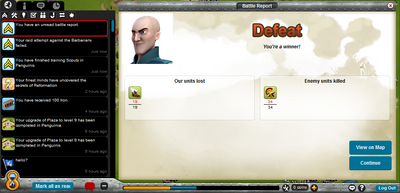Currently a battle commences when you attack map squares occupied by Barbarians and Players, or defend your cities from a Barbarian Raid. In the pre-release, there are no options for attacking player settlements. After a battle, a "battle report" appears in your activity stream that shows the troop numbers of engaging forces and losses for both armies.
Attacking[]
- Main article: Attacking
To engage in offensive battles outside of your city, you need military units and the Parade Ground building. The higher the level of the Parade Ground, the more armies you can send out - this includes occupying armies and is initially 2, but increases later on.
There is a difference between "raid" and "capture". Raiding means attacking the tile and returning home (if alive) while "capture" means your main units stay garrisoned on the tile, earning you its benefits - constant boosts to resources or culture. To successfully capture a tile, you need at least one non-air, non-artillery unit (melee, ranged, cavalry or frontline vehicle) surviving.
It is wise to make your army effective from different types of range, as they all have their strengths and weaknesses. Different ranges engage differently in rounds of combat; for example, an army of only archers or artillery is most likely going to be wiped out in melee before their second volley, and likewise, if you only include melee infantry, they will receive heavy losses from enemy arrows and shells before they attack. The same goes for cost - sometimes, cheap units in large numbers can kill an expensive one quickly.
However, another thing to consider is marching speed. This will be decided based on your slowest unit. Therefore, including artillery in a campaign to a faraway tile will severely slow you down. Marching speed can be increased with the The Steam Engine wonder.
Rounds[]
- Main article: Unit Roles; see citation for a detailed report on battle mechanics.
The various unit classes of the game can be divided into several main formation ranks:
- Air
- Armoured/Mounted Cavalry
- Melee Infantry
- Ranged Infantry
- Artillery
Ranks are ordered and then engage simultaneously. Each takes up a slot in your attacking order in each round:
- Artillery, followed by ranged, fire on the strongest enemy ranks on the field.
- All frontline units and cavalry engage the enemy units in rank order; Air will fire on any Air, attacking Armoured if there are none available.
If one of your ranks is absent, the next rank will fill its spot. If you do not have cavalry, for instance, your melee infantry engage your enemy at the same time as the enemy cavalry attack.
In an ideal one-round blitz-attack situation, artillery fires upon ranged, ranged fire upon the cavalry and the cavalry eliminate the infantry, breaking through into the artillery. This rapid elimination is similar to a "best defense is a good offense" technique, but is often hard to create and subject to random numbers.
=Speculated Defensive Mechanics[]
All units fire upon enemy rows and will eliminate units of a similar rank at the same pace; against 10 ballistae (100 AP) a combined Swordsman (Unit) and Phalanx (Unit) group will take 25 casualties; compared to 20 Phalanx or 33 Swordsman in a single group.
This can confer a defensive advantage when the armoured units absorb the
